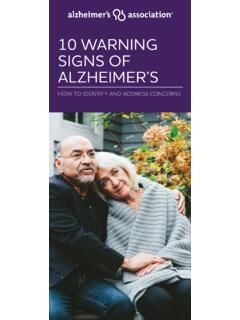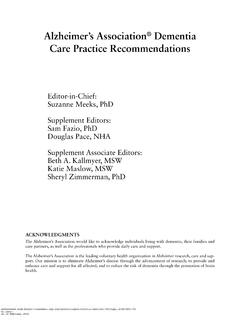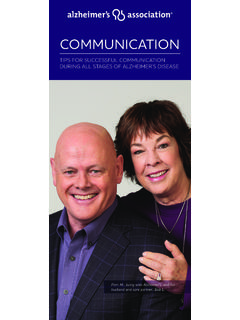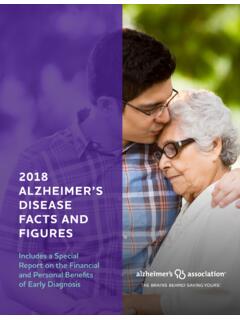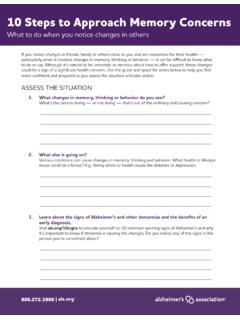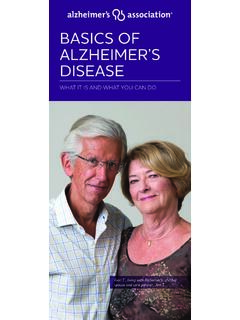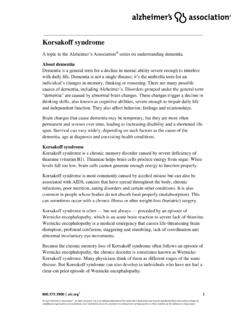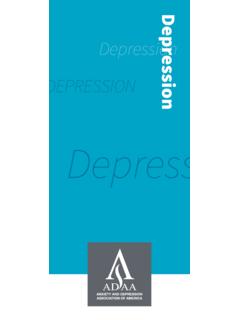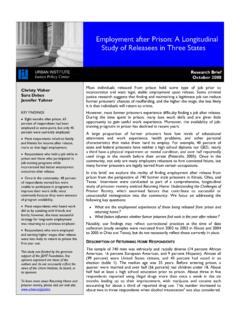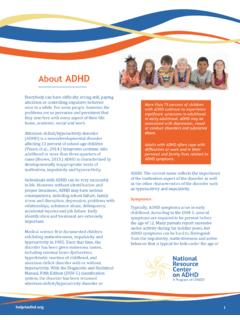Transcription of Understanding Alzheimer's and Dementia - alz.org
1 Understanding . Alzheimer's . AND Dementia . Geri T., living with Alzheimer's , and her husband and care partner, Jim THE IMPACT OF Alzheimer's . AND Dementia . Currently, an estimated 50 million people worldwide are living with Dementia , including more than 5 million Americans. Without changes in prevention or treatment, this number could reach nearly 14 million by 2050. The disease also affects the 16 million Americans who provide unpaid care for people living with Alzheimer's or another Dementia . More than 80% of care provided at home is delivered by family members, friends or other unpaid caregivers. The Alzheimer's Association is available across the country and online to help people understand Alzheimer's and Dementia , and receive information and support they can trust. CONTENTS.
2 1. Alzheimer's and 2. Alzheimer's in the 3. Risk 4. Stages of Alzheimer's 5. FDA-approved treatments for 6. Advancing Alzheimer's 1. 1. Alzheimer's . AND Dementia . The terms Dementia and Alzheimer's are often used as though they mean the same thing. They are related, but there are important differences between the two. Dementia Dementia is a broad ( umbrella ) term for an individual's changes in memory, thinking or reasoning. There are many possible causes of Dementia , including Alzheimer's . Alzheimer's Alzheimer's disease is the most common cause of Dementia . It makes up 60% to 80% of all Dementia cases. Alzheimer's is not a normal part of aging it's a progressive brain disease, meaning it gets worse over time. Two abnormal brain structures called plaques and tangles are the main features of Alzheimer's disease.
3 Scientists believe they damage and kill nerve cells. Plaques are pieces of a protein fragment called beta-amyloid that build up in the spaces between nerve cells. Tangles are twisted fibers of another protein called tau that build up inside cells. 2. Other common dementias Vascular Dementia is a decline in thinking skills that happens when blood flow to the brain is blocked or reduced so that brain cells can't get important oxygen and nutrients. Sometimes these changes occur suddenly, such as during a stroke that blocks major brain blood vessels. Vascular Dementia is the second most common cause of Dementia after Alzheimer's disease. Dementia with Lewy bodies is a type of progressive Dementia related to buildup of a protein called alpha-synuclein that damages brain cells. Early symptoms include hallucinations and sleep problems.
4 Frontotemporal Dementia (FTD) is a group of disorders. Progressive cell degeneration (or breakdown) causes FTD in two places. One is in the brain's frontal lobes (the areas behind the forehead). The other is in the brain's temporal lobes (the regions behind the ears). Visit to learn about other types of Dementia . John W., living with Dementia with Lewy bodies, and his wife and care partner, Gail 3. 2. Alzheimer's . IN THE BRAIN. More than 100 years ago, Dr. Alois Alzheimer described specific changes in the brain. Scientists now call them beta-amyloid plaques and tau tangles. Today we know that Alzheimer's is a progressive brain disease. It is marked by these key changes and impacts memory, thinking and behavior. What goes wrong in the brain The brain has three main parts: the cerebrum, cerebellum and brain stem.
5 Each has a job to do to make the body work properly. The cerebrum fills up most of the skull. It's the part of the brain most involved in remembering, problem-solving and thinking. There are about 100 billion nerve cells called neurons throughout the brain that send messages in order to make memories, feelings and thoughts. TAKE A CLOSER LOOK. Visit to explore Inside the Brain: A Tour of How the Mind Works. 4. Alzheimer's disease causes nerve cells to die. This causes the brain to lose tissue (also called shrinkage) and the loss of function and communication between cells. These changes can cause the symptoms of Alzheimer's disease. These include memory loss; problems with thinking and planning; behavioral issues; and, in the last stage, a further decline in functioning, which can even include trouble swallowing.
6 3. RISK. FACTORS. Scientists know that nerve cell failure is a part of Alzheimer's disease, but they don't yet know why this happens. However, they have identified certain risk factors that increase the likelihood of developing Alzheimer's . Age The greatest known risk factor for Alzheimer's is age. After age 65, a person's risk of developing the disease doubles every five years. Thirty-two percent of people age 85 or older have Alzheimer's . Family history Researchers have learned that people who have a parent, brother or sister with Alzheimer's are more likely to develop it than those who do not. The risk increases if more than one family member has the disease. Genetics Two types of genes influence whether a person develops a disease: risk genes and deterministic genes. Risk genes increase the chance of developing a disease but do not guarantee it will happen.
7 Deterministic genes cause a disease. This means anyone who inherits a deterministic gene will develop a disorder. 5. Rare deterministic genes cause Alzheimer's in a few hundred extended families worldwide. Scientists estimate these genes cause less than 1% of cases. Individuals with these genes usually develop symptoms in their 40s or 50s. Hispanics, African Americans and women Research shows that older Hispanics are about one-and-a-half times as likely as older whites to have Alzheimer's and other dementias, while older African Americans are about twice as likely. No one knows the exact reason for these differences, but researchers believe they are connected to higher rates of vascular disease in these groups. Also, women live longer than men, making them more likely to develop Alzheimer's .
8 However, living longer doesn't completely explain this difference. Researchers are exploring how genetic differences may impact disease risk. Lowering the risk of cognitive decline Age, family history and genetics are all risk factors we can't change. However, research is starting to show clues about other risk factors that we may be able to influence. Studies show a strong connection between serious head injury and future risk of Alzheimer's . For this reason, it's important to protect your head by buckling your seat belt, wearing a helmet when playing sports and making sure your home is safe to avoid falls. Research also shows there are healthy lifestyle habits that people can adopt to help keep their brain healthy and lower their risk of cognitive decline. These include eating a healthy diet, staying socially active, and exercising the body and the mind.
9 Not using tobacco and avoiding excess alcohol is also good for brain health. Science tells us there is a strong connection between brain health and heart health. The risk 6. of developing Alzheimer's or vascular Dementia appears to be increased by many conditions that damage the heart and blood vessels. These include heart disease, diabetes, stroke, high blood pressure and high cholesterol. The Alzheimer's Association used this research to develop 10 Ways to Love Your Brain, a collection of tips that can help lower the risk of cognitive decline. Learn more at 4. STAGES OF. Alzheimer's DISEASE. Alzheimer's usually progresses slowly in three general stages: early, middle and late. In a medical setting, these stages are sometimes called mild, moderate and severe.. The symptoms of Alzheimer's worsen over time, but because the disease affects people in different ways, the rate of progression varies.
10 On average, a person with Alzheimer's may live four to eight years after diagnosis, but some people live as long as 20 years. The following descriptions provide a general idea of changes at each stage. Stages of Alzheimer's may overlap, which can make it difficult to know which stage a person is in. 7. Early-stage Alzheimer's In the early stage, a person may function independently, but people who know the individual well may begin to notice difficulties. These can include: P. roblems coming up with the right word or name for something. T. rouble remembering names when introduced to new people. D ifficulty with familiar tasks. Forgetting something that was just read. G etting lost in familiar places. I ncreasing trouble with planning or organizing. Middle-stage Alzheimer's Middle-stage Alzheimer's is usually the longest stage and can last for many years.
